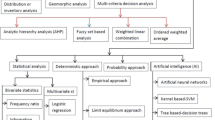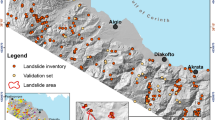Abstract
Landslide hazard and risk assessment methods can be broadly characterised as site specific or area specific. Site specific assessments may be qualitative (denoted Type I) or quantitative—based on detailed investigation and data (Type III). Area specific assessments are denoted as Type II.
This paper describes the University of Wollongong Type I method which analyses hazard and risk assessment for four different conditions: natural slopes, embankments and side fills, rock slopes and cuttings and soil cuttings. Field sheets have been developed for each type of slope to enable scoring of the factors contributing to hazard and to consequence and therefore to risk. These have been tested at 23 sites in New South Wales, Australia, by two independent professionals to establish consistency levels. Some Type III assessments have been made against which the Type I assessments were compared. In the three areas reported, the comparisons indicate that the qualitative approach is conservative.
Résumé
Les méthodes d’évaluation des aléas et risques de glissements de terrain peuvent être globalement décrites comme relatives à des études de site ou des études de zones. Les évaluations de sites peuvent être qualitatives (Type I) ou quantitatives, basées sur des données et investigations détaillées (Type III). Les évaluations de zones sont nommées de Type II.
L’article décrit la méthode de Type I de l’Université de Wollongong qui réalise l’évaluation des aléas et risques pour quatre conditions différentes : les pentes naturelles, les remblais, les pentes et excavations rocheuses et les déblais en sols. Des fiches de terrain ont été établies pour chaque type de pente afin de passer en revue les facteurs déterminants quant à l’évaluation des aléas et risques. Elles ont été testées sur 23 sites de Nouvelle-Galles-du-Sud (Australie) par deux spécialistes indépendants afin de tester leur robustesse. Quelques évaluations de type III ont été réalisées et comparées à des évaluations de Type I. Dans les trois zones concernées, les comparaisons montrent que l’approche qualitative est sécuritaire.














Similar content being viewed by others
References
Anbalagan R (1992) Terrain evaluation and landslide hazard zonation for environmental regeneration and land use planning in mountainous terrain. In: Bell DH (ed) Proceedings of the 6th international symposium on landslides, Christchurch, New Zealand, vol 2. Balkema, Rotterdam, pp 861–868
Berkman DA (1995) Engineering geology: field geologist’s manual, revised 3rd edn. Australian Institute of Mining and Metallurgy, Victoria, Australia, pp 274–302
Chang SC (1992) The simprecise mapping and evaluation system for engineering geological and landslide hazard zonation. In: Bell DH (ed) Proceedings of the 6th international symposium on landslides, Christchurch, New Zealand, vol 2. Balkema, Rotterdam, pp 905–910
Chowdhury RN, Flentje PN, Ko Ko C (1999) Aspects of recent landslide research at the University of Wollongong. In: Griffiths JS, Stokes MR, Thomas RG (eds) Landslides. Proceedings of the 9th international conference and field trip on landslides, Bristol, UK, 5–16 September 1999. Balkema, Rotterdam, pp 17–23
Cruden DM, Varnes DJ (1996) Landslide types and processes. In: Turner AK, Schuster RL (eds) Landslides investigation and mitigation special report 247. National Academy, Washington DC, pp 36–75
Fell R (1974) Landslide risk assessment and acceptable risk. Can Geotech J 31:261–272
Flentje P, Chowdhury RN, Ko Ko C (2000) A matrix approach for assessing landslide risk in the context of a comprehensive strategy. GeoEng 2000, an international conference on geotechnical and geological engineering, Melbourne, Australia, 19–24 November 2000, vol. 2. PAPERS\SNES\Snes0252.pdf. CD-Rom
Hoek E, Brown ET (1994) Classification of rock masses: underground excavations in rock, revised 1st edn. Chapman and Hall, London UK, pp 14–37
Jhingran V, Mukherjee D (1996) Engineering geological approach for the assessment of hazard. In: Senneset K (ed) Proceedings of the 7th international symposium on landslides, Trondheim, Norway, vol 1. Balkema, Rotterdam, pp 239–244
Koirala NP, Watkins AT (1988) Bulk appraisal of slopes in Hong Kong. In : Bonnard C (ed) Proceedings of the 5th international symposium on landslides, Trondheim, Norway, vol 2. Balkema, Rotterdam, pp 1181–1186
Ko Ko C (2001) Landslide hazard and risk assessment along a railway line. PhD thesis, University of Wollongong, New South Wales, Australia (unpublished)
Ko Ko C, Flentje PN, Chowdhury RN (1999) Landslide risk assessment—development of a hazard-consequence approach. In: Yagi N, Yamagami T, Jiang J-C (eds) Slope stability engineering. Proceedings of the international symposium on slope stability engineering, Matsuyama, Shikoku, Japan, 8–11 November 1999, vol. 2. Balkema, Rotterdam, pp 1309–1315
Ko Ko C, Chowdhury RN, Flentje PN (2002) Landslide hazard and risk along the Unanderra to Moss Vale railway line. Conference on railway engineering (CORE 2002), Wollongong, New South Wales, Australia, 10–13 November 2002
Ko Ko C, Flentje P, Chowdhury RN (2003) Quantitative landslide hazard and risk assessment, a case study. Quart J Eng Geol Hydrogeol 36:261–272
Kumar K, Talia DS, Kumar S (1996) Landslide hazard evaluation in a part of Himalaya. In: Senneset K (ed) Proceedings of the 7th international symposium on landslides, Trondheim, Norway, vol 1. Balkema, Rotterdam, pp 257–262
Longmac (1991) Options report to the SRA, NSW, for Unanderra to Moss Vale line, Dombarton, site M15 (incorp. site M13), side fill embankment landslip, chainage 98.800 km, September, SRA ref 1618, LM ref BGT5101/M15.025
Roads and Traffic Authority of New South Wales (1995) Guide to slope risk rating system, 2nd edn. Geotechnical Engineering Unit (Scientific Services Branch, Technical Services Directorate, RTA) (unpublished report)
RSA (1998) Rail Services Australia, New South Wales. Catalogue of geotechnical information, Unanderra to Moss Vale line, Farmborough Heights to Robertson line inspection, 91 km–130 km report 2177/1, compiled by S. Pitsis. RSA Geotechnical Service
RSA (2002a) Rail Services Australia, formerly State Rail Authority of New South Wales, Way and Works Branch, 1990–2000. Site 2758, geotechnical monitoring reports. RSA Geotechnical Service
RSA (2002b) Rail Services Australia, formerly State Rail Authority of New South Wales, Way and Works Branch, 1990–2000. Site 2759, geotechnical monitoring reports. RSA Geotechnical Service
Railway Services Authority (1997) Geotechnical risk to rail operations—NSW. Railway Geotechnical Services (unpublished report)
Sinclair TJE (1992) SCARR: a slope condition and risk rating. In: Bell DH (ed) Proceedings of the 6th international symposium on landslides, Christchurch, New Zealand, vol 2. Balkema, Rotterdam, pp 1057–1064
Standards Associations of Australia/New Zealand (1995) AS/NZS 4360:1995 Risk management.
Standards Association of Australia/New Zealand (1999) AS/NZS 4360:1999 Risk management.
Stevenson PC (1977) An empirical method for the evaluation of relative landslide risk. Intl Assoc Eng Geol Bull 16:69–72
Vecchia O (1978) A simple terrain index for the stability of hillslides or scarps. In: Geddes JD (ed) Large ground movements and structure. Wiley, New York, pp 449–461
Walker B, Baynes F, Braybrooke J, Davies W, Fell R, Leventhal A, Moon A, Volk P (2000) Landslide risk management concepts and guidelines. J News Aus Geomech Soc (AGS) 35(1):49–92
Author information
Authors and Affiliations
Corresponding author
Rights and permissions
About this article
Cite this article
Ko Ko, C., Flentje, P. & Chowdhury, R. Landslides qualitative hazard and risk assessment method and its reliability. Bull Eng Geol Environ 63, 149–165 (2004). https://doi.org/10.1007/s10064-004-0231-z
Received:
Accepted:
Published:
Issue Date:
DOI: https://doi.org/10.1007/s10064-004-0231-z
Keywords
- Landslide hazard
- Risk assessment
- Slope stability
- Observational approach
- Influencing factors
- Qualitative and quantitative methods




